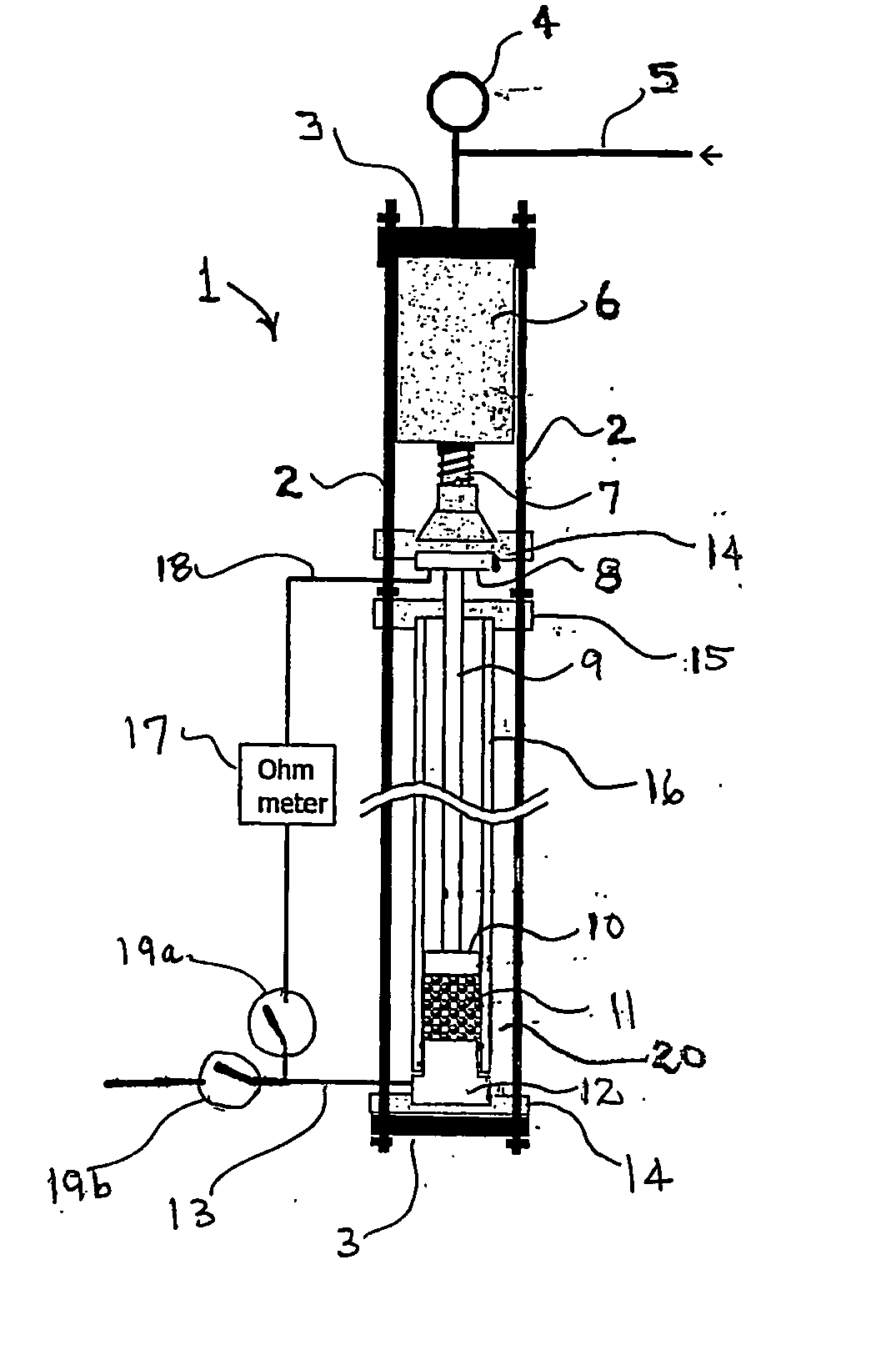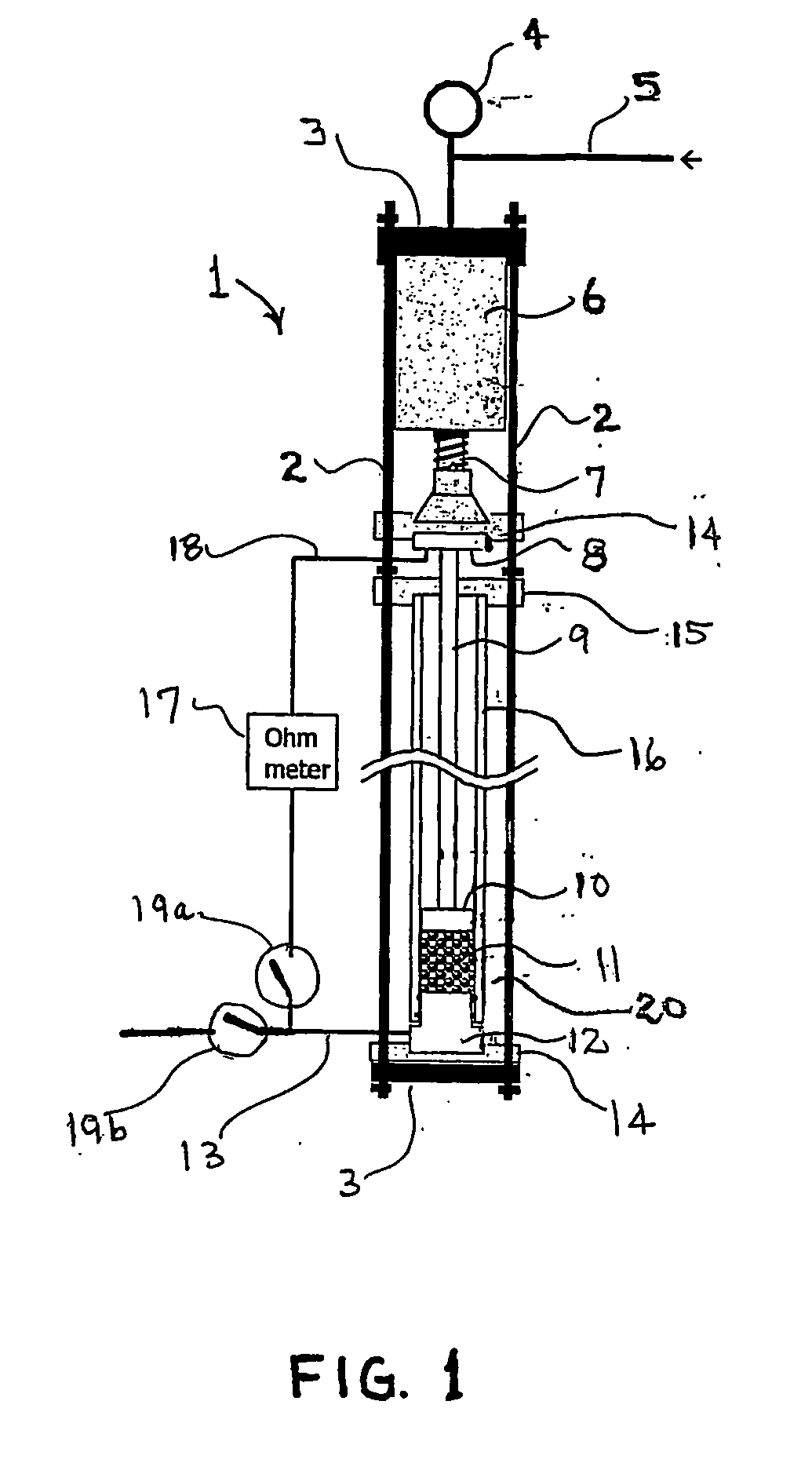Carbonized charcoal electrode
a carbonized charcoal and electrode technology, applied in the field of carbonized charcoal, can solve the problems of impracticality of carbon fuel cells, cost of carbonizing powdered charcoal, bonding,
- Summary
- Abstract
- Description
- Claims
- Application Information
AI Technical Summary
Benefits of technology
Problems solved by technology
Method used
Image
Examples
example 1
[0033] Samples (0.5 g) of 20 / 40 mesh macadamia nutshell charcoal which had been carbonized for 10 min at temperatures of 650, 750, 850, 950, and 1050° C., were loaded into the apparatus shown in FIG. 1 and the electrical resistivity of the packed-bed, carbonized-charcoal electrode was measured as a function of applied pressure. Referring to FIG. 2, the electrical resistivity of the carbonized-charcoal packed bed decreased by more than five orders of magnitude as the carbonization temperature increased from 650 to 1050° C. Similarly, in FIG. 2 the electrical resistivity of the packed bed of carbonized-charcoal powder decreased by about a factor of 10 as the applied pressure delivered by the piston 10 (see FIG. 1) increased from 0 to about 8 MPa. For comparison, graphite powder was loaded into the apparatus and the resistivity of the graphite powder electrode was measured as a function of increasing pressure. As shown in FIG. 2 an electrode composed of a packed bed of macadamia nutshe...
example 2
[0035] A sample (0.49 g) of 20 / 40 mesh coconut husk charcoal, which was carbonized at 950° C., was loaded into the apparatus and the electrical resistivity of the packed-bed, coconut husk carbonized-charcoal electrode was measured as a function of applied pressure for two pressurization / depressurization cycles. As shown in FIG. 3, the electrical resistivity of the coconut husk carbonized-charcoal electrode decreased to a value of 0.18 Ω-cm as the pressure applied to the electrode by the piston increased to about 6 MPa. FIG. 3 also displays the length of the carbonized-charcoal packed bed as a function of pressure. Prior to the first compression the bed was loosely packed and manifested a low electrical conductivity, but following the first compression the compacted bed was relatively dense (0.46 g / cm3) and virtually incompressible.
example 3
[0036] A sample (0.5 g) of 20 / 40 mesh kukui nutshell charcoal, which was carbonized at 950° C., was loaded into the apparatus and the electrical resistivity of the packed-bed, kukui carbonized-charcoal electrode was measured as a function of applied pressure for two pressurization / depressurization cycles. As shown in FIG. 4, the electrical resistivity of the kukui nutshell carbonized-charcoal electrode decreased to a value of 0.18 Ω-cm as the pressure applied to the electrode by the piston increased to above 6 MPa. FIG. 4 also displays the length of the carbonized-charcoal packed bed as a function of pressure. Prior to the first compression the bed was loosely packed, but following the first compression the compacted bed was quite dense (0.82 g / cm3) and virtually incompressible.
PUM
| Property | Measurement | Unit |
|---|---|---|
| Temperature | aaaaa | aaaaa |
| Pressure | aaaaa | aaaaa |
| Size | aaaaa | aaaaa |
Abstract
Description
Claims
Application Information
 Login to View More
Login to View More - R&D
- Intellectual Property
- Life Sciences
- Materials
- Tech Scout
- Unparalleled Data Quality
- Higher Quality Content
- 60% Fewer Hallucinations
Browse by: Latest US Patents, China's latest patents, Technical Efficacy Thesaurus, Application Domain, Technology Topic, Popular Technical Reports.
© 2025 PatSnap. All rights reserved.Legal|Privacy policy|Modern Slavery Act Transparency Statement|Sitemap|About US| Contact US: help@patsnap.com



